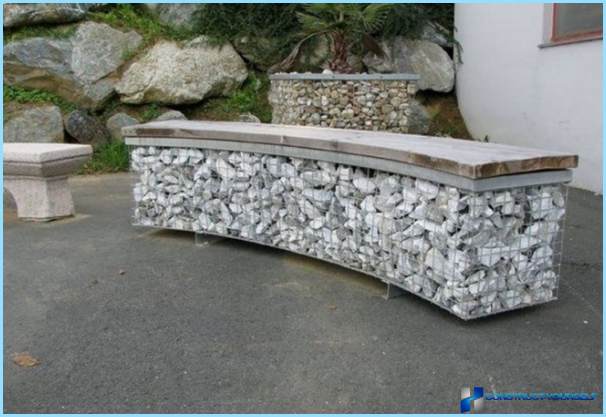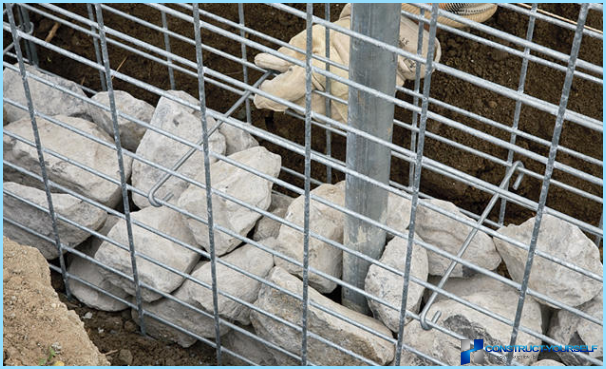The contents
Gabion is a large metal cage, which is made of twisted wire. This design is very simple to manufacture and the placing on the territory of the site. This design is not expensive, and at the same time reliable to use. Her need to care.
Advantages of gabions ↑
If you compare the gabions with other similar structures, it becomes clear filters have great advantages. Their advantages include:
- high durability as it is able to withstand heavy loads;
- each mesh structure can be mounted on the other, it requires only galvanized wire, in the end, it is possible to obtain a monolithic structure;
- they are a good match with the rest of the landscape, so over time the efficiency of such facilities will only grow;
- low cost of use and installation;
- easy installation due to light weight products.
Gabions have a lot of advantages, thanks to which they became widespread in different sectors and areas.

The variety of gabions ↑
Depending on the form of the following primers:
- box;
- cylindrical;
- flat.
From this it follows that the frame shape will be similar to a cylinder, a flat shape or a box shape, it must be made of mesh or from welded construction.
In welded construction the rods that are placed perpendicular to each other, are welded together at the intersections. Welded boxes are rectangular in shape, in order to connect walls, make a wire spiral.
The mesh design is created by mounting the steel mesh on a rigid frame. Each cell in this grid is obtained hexagonal shape.

How to make a gabion with his own hands ^ a
Before proceeding to the construction of gabions, care should be taken the following material, which you definitely need:
- metal mesh, the thickness of which should be from 0.2 to 0.8 cm, depending on the parameters of the product. It is necessary to consider features of operation;
- fittings. It strengthens the frame and it is given rigidity;
- staples for wire and spirals of metal. These materials are used in order to seal the details of construction;
- the geotextile. This material is required in order to create a reverse filter, and to reduce the consumption of sand or other material for embankment during the installation work.
Be sure to take stones. If you appearance is important, choose a material, different colors or unusual shapes. For this you need to give your imagination.
To work on manufacturing and installation of gabions, we need simple tools, many of which you probably already have: pliers or pliers, a stapler for mounting, tire iron, shovel and bolt.

Produce the frame ↑
Since the weight of even small structures will be significant, manufacture and Assembly of the frame of the gabion should be carried out on-site.
The manufacturing process of the gabion takes place in several stages. To start prepare the ground, if possible, it is better to strengthen, for example, tamp the soil or remove the top layer of soil. Use sand for the manufacture of cushions, thickness of which will be from ten to twenty centimeters. All will depend on what is the weight and parameters of the gabion.

The grass and other weeds overgrown on the mesh of the gabions must be made around the whole structure a shallow ditch. Then the ditch should be covered with a geotextile fabric or plain black tape, secure it, tucked one edge under the future design.

Then, you want to cut the mesh in accordance with pre-calculated size and start connecting.
You first need to set the bottom of the structure, and to put it to the side and fasten them together with wire of metal. The remaining wire must screw tightly and secure it using the pliers.

If your gabion needs to be quite large or disproportionately long one of the sides, you should consider the diaphragm stiffness. One of the parties must be open to be able to fill in the design with stones.

Latest stitching should be done after all installation works will be completed and completely filled the entire volume.
After all the work to make a frame design, it needs to be installed and fixed. To ensure the strength and reliability not only due to its own weight, the design should be anchored with anchors or improvised stakes. You can also use the rebar, whose diameter should not exceed 1 cm.

In the manufacture of a design consisting of not one layer, you can prevent the possibility of saving material, for example, in the construction of fences. In this case gabiony mesh lower layer can be the bottom for the top.
Fill the gabion with stones ↑
After the finished design installed and rigidly fixed to each other, you can proceed to the next stage – laying the stones. It is not a difficult step, but requiring compliance with certain rules:
- start filling when the gabion was in its place;
- if internal content is selected stones of various size, the largest should be laid along the edges and the center to fill with smaller stones;
- if you use small stones of same shape and size, you need to put them in bulk in several steps with compaction of all parts;
- at the height of the gabion, more than 1.5 meters should lay the stones in several layers, the thickness of each of them should be from 15 to 25 cm in addition, once the design will be filled by 1/3, you will need to do stretching-girth, which is bonded the opposite side in order to prevent deformation;

- if the gabion will consist of many levels, the bottom row should be filled with stones, considering their shrinkage under the action of its own weight and under the action of external loads, so they need to be filled on the average on 5-7 cm above the upper edge of the structure;
- sometimes you can prevent the use of stones having a smaller fraction than the unit cell parameters, but then, they must be laid in the middle of the design or at the bottom of the structure, previously they need to wrap the geotextile, which will not create a barrier to water seeping through the gabion, but it will not let it be washed out of the gabion filler;
- after completed the installation and filling of the gabion, you need to perform the last action is to cover the set design of the lid, and lock it by means of a metal spiral wire.

Conclusion
Gabions are a good tool for cheap and cheerful to create a decor in your personal plot or garden. This type of landscape design is flexible and mobile. And it gives vent to your imagination.

Your masterpieces will look respectable and beautiful. And the main manufacturer of the gabion can be done with your hands and with minimal costs. A little bit of imagination and fantasy, be a designer, create and give joy to your loved ones and others. After all, when your eyes will delight such a beautiful landscape design elements such as gabions, you will improve the mood and the soul will be easy.
What is a gabion in landscaping? The lessons of the designer manufacturer







